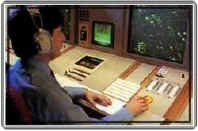Keeping Track Of Flights
By the end of the first decade of powered flight, people began to realize that aircraft, like automobiles, would crash into each other unless some means was developed to control and direct them.
At first, because aircraft could not fly very high, such control was accomplished using simple hand signals. Later, control was exercised through radio communication.

By the end of World War II,An ATCO at work the invention of radar permitted visually displayed tracking of several aircraft at once. When coupled with radio communication, radar made it possible for the pilot to be warned when he was in danger of colliding with another aircraft or when he was off course. Today, aircraft are continually tracked from take-off to landing
History of Air Traffic Control
Archie William League (1907-1986), is widely acknowledged as the first U.S. air traffic controller with his claim to the first air traffic controller largely unchallenged. After becoming a licensed airplane and engine mechanic, flying and barnstorming around Illinois and Missouri with his own 'flying circus' , Archie was hired by the city to direct the growing air traffic at St. Louis's Lambert Field. His "control tower" was a wheelbarrow on which he mounted a beach umbrella for the summer heat. In it he carried a beach chair, his lunch, water, a note pad and a pair of signal flags to direct the aircraft either to 'GO' or 'HOLD'. In the winters, he wore a padded flying suit to keep warm out on the field.
